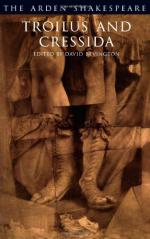|
This section contains 4,344 words (approx. 15 pages at 300 words per page) |

|
SOURCE: "Violence, Love, and Gender in Romeo and Juliet and Troilus and Cressida," in Love's Argument: Gender Relations in Shakespeare, The University of North Carolina Press, 1984, pp. 99-124.
In the excerpt below, Novy studies the gender distinctions in Troilus and Cressida, observing that "in the external world, masculinity is identified with violence and femininity with weakness."
When we leave the comic world Shakespeare's plays show societies with a much more rigid sense of gender distinctions. However, it is not always the male character's desire to monopolize the role of actor and his suspicion of female pretense that enforce these distinctions. In three of Shakespeare's plays, female and male characters share the title. These plays all deviate from the male-actor—female-audience pattern that dominates in Hamlet, Lear, Macbeth, and Othello and resemble the comedies in other ways as well. In Romeo and Juliet and Troilus and Cressida, as in...
|
This section contains 4,344 words (approx. 15 pages at 300 words per page) |

|


